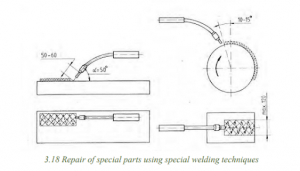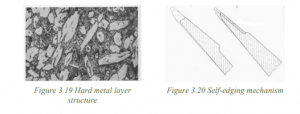Lesson 6: Methods that meet today’s requirements – surface reinforcement
In this lesson, we will delve into Surface Reinforcement by Open Arc Welding and the Repair of Special Parts Using Special Welding Procedures.
- SURFACE REINFORCEMENT BY OPEN ARC WELDING
Introduction
- Surface reinforcement involves applying a hard, abrasion-resistant layer to protect the base surface.
- This technique is highly effective in extending the lifespan of various components.
Tools and Materials
- Tubular wire with specific functions like arc stabilization, deoxidization, fluidization, carbide forming, and additives for desired properties.
- Common diameter range: 2-4 mm (e.g., 2.8 mm).
- Applications include low carbon, non-alloyed, Mn, Mn-Cr alloy structural steels, and more.
Process
- Surface preparation involves cleaning and defect type assessment.
- Rounding edges and corners and marking crack traces.
- Application of the tubular wire to create a hard, abrasion-resistant layer.
- Considerations for specific material compositions and requirements.
Applications
- Ideal for reinforcing low carbon and alloyed structural steels.
- Butt and fill-up welding of medium carbon alloy steels.
- Suitable for forming stainless steel surfaces (Cr, Mn, Ni).

- REPAIR OF SPECIAL PARTS USING SPECIAL WELDING PROCEDURES
Machine Frames, Frame Structures, Leaf Springs
- Common failures include cracking, fracture, and embrittlement.
- Risk of indentation or annealing during welding due to material composition.
- Recommended hardness test in the weld area before reuse.
Welding Technology
- Direct current with positive polarity.
- Electrode materials with high Cr, Ni, and Mn content for adequate elasticity and tensile strength.
- Target tensile strength of the weld: 800-850 MPa.
Minor Chipping, Fracture of Pinions, Sprockets, Rib Shafts
- Components subjected to frequent and unpredictable conditions.
- Preheating to 500-600°C required before welding.
- Use of a fluxing agent for proper flaw space filling.
- Selection of welding rod characteristics: Cr, Ni, Si alloys, low melting point, high hardness.
Highly Stressed Cutting Edges for Machine Tools
- Carbide filling and sharpening methods.
- Suitable welding processes and bonding methods.
- Deposition of materials with excellent abrasion resistance, containing metal carbides, nitrides, and borides.
Self-Sharpening Concept
- The concept explained in the context of carbide charging, ensuring the effectiveness and longevity of tool surfaces.
Coated-Electrode Manual Arc Welding
- Performed with direct current and bonded with positive polarity.
- Preparation steps include removing previous armor, preheating, and applying a flexible pad layer if needed.
Conclusion
- Surface reinforcement and special welding procedures are essential in prolonging the life of components subjected to harsh conditions.
- Understanding these methods is crucial for professionals involved in the maintenance and repair of specialized parts.
